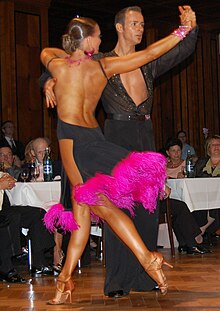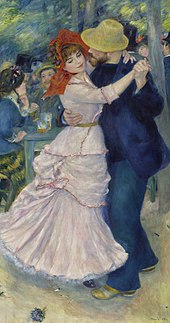what partner dance means to turn in german


Partner dances are dances whose basic choreography involves coordinated dancing of two partners, equally opposed to individuals dancing alone or individually in a not-coordinated fashion, and equally opposed to groups of people dancing simultaneously in a coordinated manner.
United States dance history [edit]
Prior to the 20th century many ballroom trip the light fantastic toe and folk dances existed in America. As jazz music developed at the start of the 20th century, African American communities in tandem developed Charleston and eventually Lindy Hop past the end of the 1920s. Many cities had regular local competitions such as the Savoy Ballroom which accelerated the development and popularization of the dance. The dances were introduced to wider public through movies and regular performances such as those done at the Cotton Social club in New York.[1]
An unusual (for the time) feature of the trip the light fantastic was the inclusion of sections where the dancers would move apart from each other, and perform individual steps (known as the "breakaway"). Another unique feature that was introduced in these early days were the beginning airsteps, likewise known today as aerials. These daring maneuvers were exciting for the audiences to sentinel, and when combined with live performances such as those past Ella Fitzgerald, became a staple of organized Lindy Hop performances.[two]
Other dances such as Collegiate Shag and Balboa adult in the United states in the same fourth dimension period by never saw the aforementioned international popularity as Lindy Hop.[3]
Over the next few decades, pop music inverse, moving away from the big ring sound of swing to styles like rhythm and blues and then rock and roll. Due to this and other factors, the Lindy Hop evolved and mutated into a number of different styles. Trip the light fantastic styles such as West Coast Swing and Modern Jive integrated features of ballroom dances and new music to create distinctive but similar dances.[four]
German trip the light fantastic toe history [edit]
In 1023, the German language poet Ruodlieb referred to a couple dance with a basic motif of a boy wooing a girl, and the daughter rejecting his advances. Men and women dancing equally couples, both belongings one hand of their partner, and "embracing" each other, can be seen in illustrations from 15th-century Federal republic of germany.[v]
At the terminate of the 13th century and during the 14th century, nobles and wealthy patricians danced equally couples in procession in a irksome dignified style in a circumvolve, while farmers and lower classes danced in a lively fashion. The burgher heart class combined the dances with the processional as a "fore dance", and the turning as an "after dance".[half dozen]
The Danse de Paysans' (Peasant'southward Dance) past Théodore de Bry shows a couple with a human lifting his partner off the ground, pulling her towards him while holding her closely with both arms. His Danse de Seigneurs et Dames (Dance of the Lords and Ladies) features i Lord with his arms effectually the waist of his Lady.[7] Syncopated rhythms gained widespread popularity for dancing in the terminal two centuries, although usually less circuitous and more regular than previous music.[viii]
An former couple dance which can be found all over Northern Europe is known every bit "Manchester" or "Lott is Dead". In Bavaria words to the music include "One, two, three and i is iv, Dianderl lifts up her brim And shows me her knees", and in Bavaria one verse invites the daughter to go out her chamber window open to allow a visit from her partner.[ix]
Trip the light fantastic partners stay together for the duration of the dance and, virtually often, dance independently of other couples dancing at the same time, if any.
Although this kind of dancing can be seen, for instance, in ballet, this term is normally applied to various forms of social dance, ballroom dance, folk dance, and like forms.
Group dances [edit]
Partner dance may exist a basis of a formation dance, a circular trip the light fantastic, a square trip the light fantastic or a sequence dance. These are kinds of group trip the light fantastic toe where the dancers form couples and dance either the aforementioned choreographed or called routines or routines within a common choreography—routines that command both how each couple dances together and how each couple moves in accord with other couples. In square dance one will often alter partners during the class of a trip the light fantastic toe, in which case 1 distinguishes betwixt the "original partner" and a "situational partner".
Leader and follower [edit]
In most partner dances, i is the leader and the other is the follower. As a dominion, they maintain connectedness with each other. In some dances the connection is loose and called dance handhold. In other dances the connexion involves body contact. In the latter example the connection imposes pregnant restrictions on relative body positions during the trip the light fantastic toe and hence it is ofttimes chosen trip the light fantastic toe frame. It is as well said that each partner has their own dance frame. Although the handhold connection poses well-nigh no restriction on body positions, it is quite helpful that the partners are aware of their trip the light fantastic frames, since this is instrumental in leading and following.
In promenade-style partner dancing in that location is no leader or follower, and the couple trip the light fantastic toe side-past-side maintaining a connection with each other through a promenade handhold. The leader dances traditionally to the left of the follower.
Some peoples accept folk partner dances, where partners do not take whatever trunk contact at all, but there is still a kind of "call-response" interaction.
A popular form of partner dancing is slow trip the light fantastic toe.

History of same-sex partner dancing [edit]
Generally, partner dance has taken place between a human being and a woman. Before the 1950s, even so, if there was non a sufficient number of partners of the contrary sexual activity available, couples formed into pairs of the same sex activity.
Sometimes this is as well done as part of a dance tradition. In traditional partner dances done within sure bourgeois cultures, such as in traditional Uyghur partner dance, dancing is often done with the same sex as a thing of respect for the bourgeois culture.
Every bit learning both trip the light fantastic toe roles has become more common and social norms have changed, many events and competitions have removed restrictions.
Typically, in ballroom competitions today, same-sexual activity partnerships are allowed up to the silver level (the third level in contest, after newcomer and bronze). However, these are comparatively rare.
It is idea[ by whom? ] that some partner dances actually developed with more relaxed gender roles. Prior to adoption by the mainstream, these dances did not actually normalize the man-atomic number 82/woman-follow paradigm.
Double partner dancing [edit]
This kind of dance involves dancing of 3 persons together: ordinarily one man with 2 women or ane woman with ii men. In social dancing, double partnering is best known during times when a significant demographic disproportion happens between the ii sexes. For example, this happens during wars: in the military, in that location is a lack of women, while amidst civilians, able dancers are generally women. For instance, during the Second Globe War, many avant-garde leaders learned to trip the light fantastic Lindy Hop with ii followers.
Since the 1980s, double partner dance is often performed in Ceroc, Hustle, Salsa and Swing dance communities, experienced leaders leading 2 followers.
There are a number of folk dances that characteristic this arrangement. Amid these are the Russian Troika and the Polish Trojak folk dances, where a human dances with 2 or more than women. A Cajun trip the light fantastic with the proper noun Troika is as well known.

Students participating in a group course for double partner dancing.
Run into likewise [edit]
- Outline of trip the light fantastic
- List of dances
- Pas de deux
References [edit]
- ^ "History". lurklurk.org . Retrieved 2019-08-xiv .
- ^ "History". lurklurk.org . Retrieved 2019-08-14 .
- ^ "The Lindy Circle - Balboa History". world wide web.lindycircle.com . Retrieved 2019-08-14 .
- ^ "History". lurklurk.org . Retrieved 2019-08-14 .
- ^ Folk Trip the light fantastic of Europe. Nigel Allenby Jaffé. 1990. Folk Dance Enterprises. pages 148, 149. ISBN 0-946247-14-5
- ^ Folk Trip the light fantastic toe of Europe. Nigel Allenby Jaffé. 1990. Folk Dance Enterprises. pages 155, 156. ISBN 0-946247-xiv-5
- ^ Folk Trip the light fantastic toe of Europe. Nigel Allenby Jaffé. 1990. Folk Dance Enterprises. page 150. ISBN 0-946247-xiv-v
- ^ Folk Dance of Europe. Nigel Allenby Jaffé. 1990. Folk Trip the light fantastic Enterprises. page 166. ISBN 0-946247-14-v
- ^ Folk Dance of Europe. Nigel Allenby Jaffé. 1990. Folk Trip the light fantastic Enterprises. page 163, 164. ISBN 0-946247-xiv-five
External links [edit]
- International DanceSport Federation
- World Trip the light fantastic toe Council
- International Professional DanceSport Council
Source: https://en.wikipedia.org/wiki/Partner_dance
0 Response to "what partner dance means to turn in german"
Post a Comment